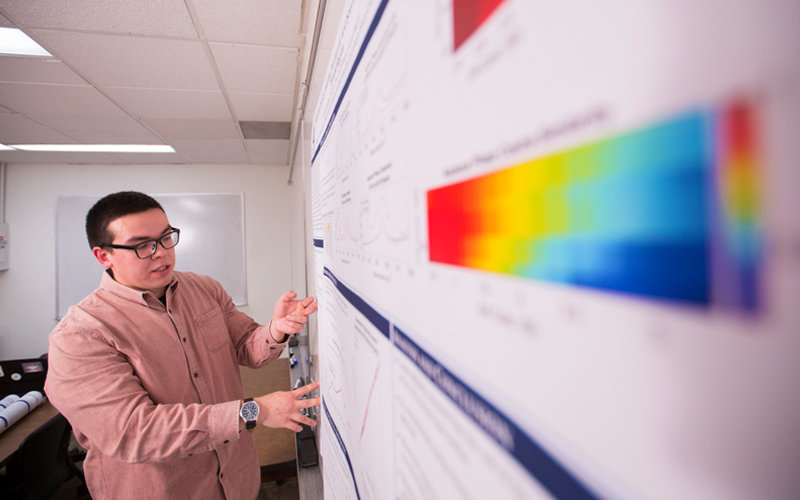
Math meets chemistry for undergraduate Cameron Hooper, whose research project focuses on the effects of atmospheric aerosol particles on climate change.
The mathematics major works with faculty mentors Laura Smith, assistant professor of mathematics, and Paula Hudson, associate professor of chemistry and biochemistry, on a joint project using mathematical methods to identify atmospherically relevant compounds that might influence climate change.
A research scholar in CSUF’s Graduate Readiness and Access in Mathematics program, known as GRAM, Hooper is one of four student mathematicians who received a Mathematical Association of America (MAA) Outstanding Poster Award for their undergraduate research. The scholars presented their research projects at the recent Joint Mathematics Meetings of MAA and the American Mathematical Society in San Diego.
The other CSUF outstanding poster presentation award winners are students James Shade and Christian Do, mentored by Adam Glesser, associate professor of mathematics, and Matthew Rathbun, assistant professor of mathematics; and Saul Lopez, mentored by Scott Annin, professor of mathematics.
More than 650 students presented over 400 research projects at the national meeting, with CSUF student mathematicians vying against peers from such universities as MIT, Harvey Mudd College, Harvard University, UCLA, as well as California State University campuses.
The Math Behind the Research
Aerosol particles can directly interact with incoming solar radiation and outgoing terrestrial radiation by either absorbing or scattering the radiation, which can either cause a warming or cooling effect at the Earth’s surface, Hudson explained.
“The degree to which an aerosol particle affects climate is primarily dependent on the particle composition, but size, shape and phase also play a role. In order to reduce uncertainties in our understanding of how aerosol particles affect climate, it is helpful to combine measurements of aerosol properties with models that have predictive capabilities,” she added.
This research provides other scientists with a way to identify compounds in a measurement, Hooper pointed out, adding that “scientists can see if certain atmospherically relevant compounds influence the climate via a cooling or heating effect.”
Hooper, a 2017 research scholar in the Louis Stokes Alliances for Minority Participation program, plans to graduate in 2020 then pursue a doctorate in mathematics and a career in industry or government.
Shade explained that their research focuses on the concept of symmetry, which has a wide variety of applications — from artistic composition to orientation of molecules.
“A symmetry of an object is an action we can perform on that object that gives us back an object with the same properties. For instance, if we have a square, we can rotate that square by 90 degrees, and we will get a square that looks exactly the same, so this rotation is a symmetry.”
Our research focuses on a particular algorithm for finding symmetries, and our main question is ‘If we have two of the symmetries of an object, when can we use this algorithm to find all of the rest?'”
Shade added that their project has potential applications in coding theory, especially in computer programs that work with symmetries. “A consistent and algorithmically simple method of generating these symmetries can help with efficiency and simplicity of code,” he added. A CSUF President’s Scholar and a GRAM scholar, Shade plans to pursue a doctorate in mathematics after he graduates in May.
For Lopez’s research, he is studying a “generating set” for an algebraic structure — like building blocks or DNA of a structure — where the entire structure can be constructed from the foundational elements in the generating set.
The research could potentially be used in fields such as computer science and cryptography, Lopez noted. For instance, in computer science, it is important to store data that has been expressed in terms of elements of a generating set as concisely as possible. This can serve to speed up various computer algorithms and processes, Annin added.
For the young mathematicians, participating in faculty-mentored research and presenting at conferences gives them the opportunity to share their work and network with peers, and also learn more about their areas of study.
“As a first-generation university student, doing research opened my eyes to a new world in academia — and attending conferences like MAA helped widen that world,” said Lopez, who plans a career teaching mathematics at the community-college level.